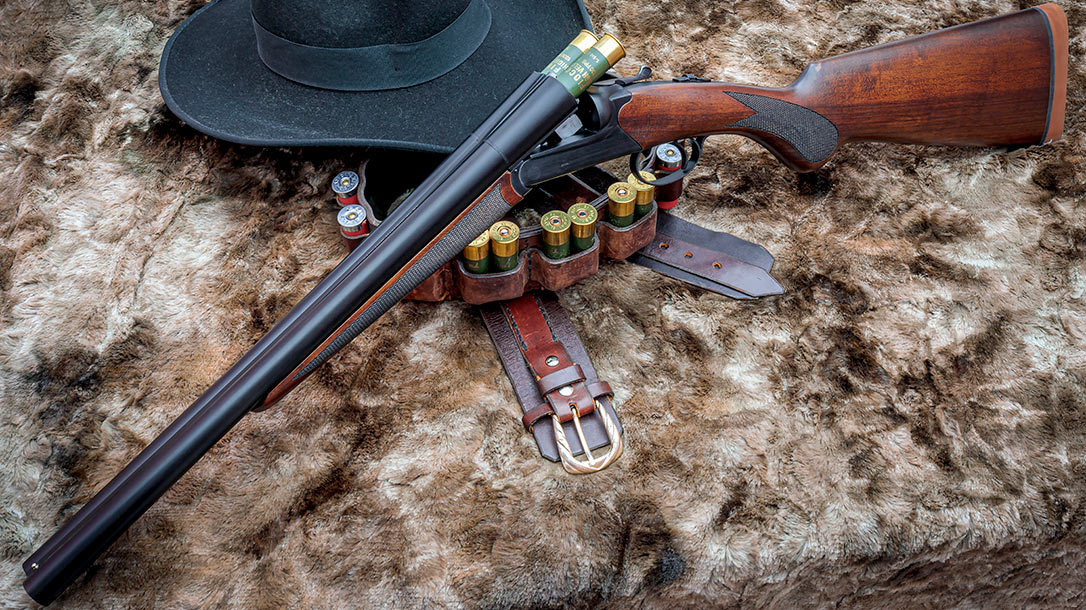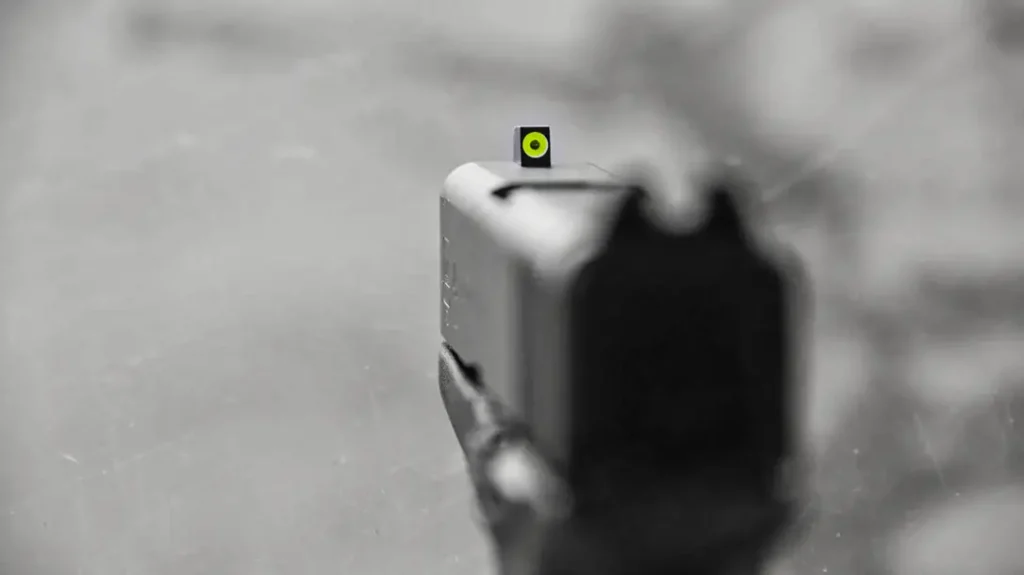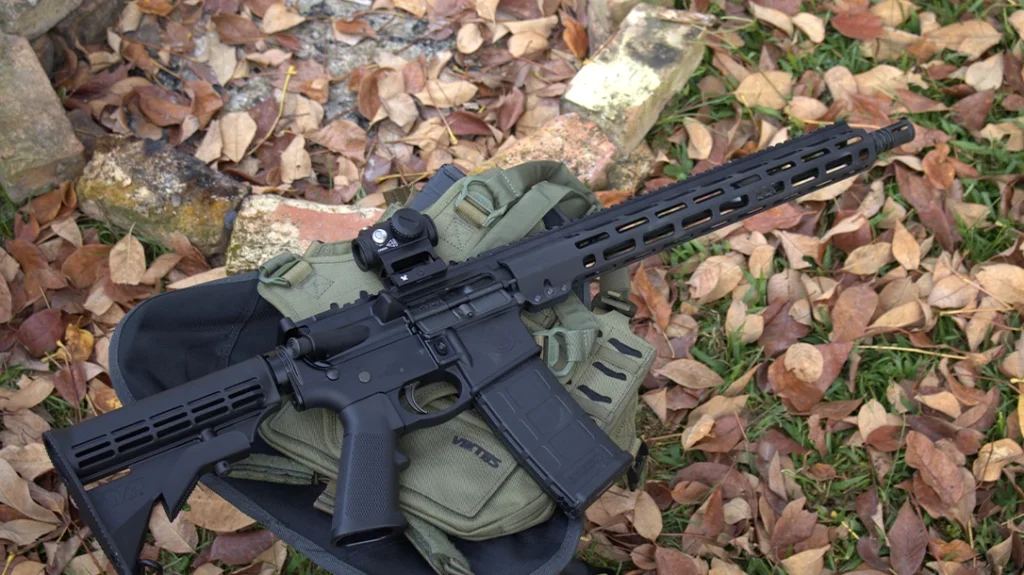The shotgun has always been one of the most versatile firearms in American history. Fowling pieces put meat on the table in pioneer homes. Not very different from the smoothbore muskets of the era, it could also arm a militiaman. And coach guns, like the Navy Arms Coach Gun, helped forge our country.
The Navy Arms Coach Gun
As self-contained cartridges and shells were perfected, the double-barrel shotgun was popular for hunters. However, others saw the benefits too. Short-barrel versions protected stagecoaches, railroad express cars, and armed peace officers.
Of course, outlaws also put them to use. A 10- or 12-gauge double-gun pointed at you was persuasive, knowing each barrel held a lethal charge of buckshot. Nowadays, shotguns are still in every hunter’s gun safe, and good guys and bad guys still employ them. Likewise, folks that enjoy reliving the Old West use them in match stages at Cowboy Action Shooting (CAS) competitions.
Advertisement — Continue Reading Below
The double-barrel shotgun, with or without external hammers, is still the odds-on favorite. For this reason, many CAS folks keep an eye out for new shotguns that meet CAS criteria hitting the market.
Shotgun Details
Navy Arms (NA) has been in the replica firearms business for 65 years. Starting with a brass frame Colt 1851 Navy reproduction from Italy, they’ve imported or built 100 different models of classic firearms.
One of the newest products they have brought to our shores is simply called the Coach Gun. This harkens back to days gone by when stagecoaches, like those operated by Wells Fargo, had a “shotgun messenger” who rode in the “box” beside the driver.
Advertisement — Continue Reading Below

He rode “shotgun” to protect the valuables and passengers aboard the coach, and the short-barrel scattergun was the preferred tool. It allowed the messenger to effectively fire on adversaries while the coach was on the move or pulled up. This is as long as engagement distances were reasonable.
Break Action Scattergun
The new NA Coach Gun is a Turkish import, and I’ll tell you, those folks make some really fine shotguns these days. This is a side-by-side double-gun with 18.5-inch barrels and will accept 12-gauge shells up to the powerful 3-inch Magnums. There’s a solid, concave rib that runs from the breech to the muzzle, where there is a bead front sight.
Advertisement — Continue Reading Below
Both barrels have interchangeable choke tubes, and the Coach Gun comes with a choke tube set and wrench to screw in the chokes. This shotgun has an internal boxlock action with no external hammers. Break open the action by pressing the top lever to the right and pushing the barrels downward. This cocks the internal hammers and readies the gun for loading.

As per Cowboy Action Shooting regulations, the Coach Gun does not have automatic ejectors. The extractor lifts the shells out of the chamber just far enough for removal. Closing the action makes the gun ready to fire.
Advertisement — Continue Reading Below
This is a single-trigger action, so the trigger must be pulled separately for each barrel to fire. The manual safety button is on the tang behind the top lever and must be pulled back to engage. With it in the on-safe position, it also serves as a barrel selector. Likewise, moving it to the right or left selects which barrel will fire the first time the trigger is pulled.

The Coach Gun has a decent enough trigger pull for a shotgun.
Advertisement — Continue Reading Below
Solid Construction of the Coach Gun
Each Coach Gun receiver is made from precision-machined forged steel that is hand fitted. The receiver, trigger, triggerguard, barrels, and Deeley forend release are all satin-polished and blued. The interior of the barrels appears to be chrome-plated.
I’m pleased to report that the receiver is not cluttered up with a bunch of laser-engraved designs and lettering. However, the bottom of the receiver does have a likeness of the renowned Navy Arms emblem.

Advertisement — Continue Reading Below
Stocks on the Coach Gun are fashioned from nicely figured walnut that has a hand-rubbed oil finish. The buttstock has a rounded, Prince-of-Wales pistol grip, which is finely checkered. There is also a traditional burnt-orange, solid recoil pad with a black spacer.
Length-of-pull on the buttstock is 14.5 inches. The regular splinter-type forend has panels of fine checkering on each side. The wood-to-metal fit is very good, except at the end of the tang, where there is a noticeable gap. The metal-to-metal fit is outstanding, and the lock-up is tight.

Advertisement — Continue Reading Below
The Coach Gun comes in a cardboard box that is segmented for the major parts, with cloth bags covering the receiver/buttstock assembly and forend/barrel assembly. A small plastic case contains the Beretta Mobil chokes and wrench.
There are various chokes, such as improved cylinder, modified, full, and skeet. The chokes that were installed in my test gun were left barrel full and right barrel modified. Small lines stamped in the muzzle end of the choke identify its type, and there’s a choke tube guide on page 8 in the owner’s manual that’s included.
Take-down for cleaning is like all double-guns. I won’t inflate the word count explaining this, so if you buy a Coach Gun, read the manual.
Advertisement — Continue Reading Below
Shotshells
Even though we were in the midst of the hunting season, I was able to obtain three different kinds of 12-gauge shotshells for the shooting test. CAS regulations generally call for lead shot in sizes 7-1/2 or 8, which is bird or target shot.
Most shooters use “low-brass” target or small-game velocity loads (1,200 fps). This makes for reduced recoil, faster follow-up shots, and less wear and tear on steel targets.
Two brands of shells I used were of this variety. One was from Estate Cartridge of Minnesota. Their Super Sport Competition Target load is a 2-3/4-inch red plastic hull, low-brass shell with 1-1/8 ounces of #7-1/2 shot.
Then I had Remington’s Gun Club Target Loads, also a 2-3/4-inch plastic hull, which is Remington Green and low-brass with the same shot load as the Estate.
I guess I needed to read the box label closer, but my third box of shells was from Fiocchi. Although it’s also a 7-1/2 shot, the charge was 1-1/4 ounces with a 1,330 fps velocity. The 2-3/4-inch OD Green plastic hull has a high-brass base.
I didn’t use traditional paper patterning targets that have a large circle on white paper with a center aiming point. Instead, I used Birchwood Casey Shoot-N-C B-27 target centers. They have a self-adhesive back and fit on police-type B-27 humanoid silhouette targets as a replacement center, having oval-shaped scoring rings.
What I like is when a projectile penetrates the black-colored target, the hole has a nice yellow “halo” around it. This makes it easy to see. The B-27 centers are about the size of common CAS knock-down shotgun targets too. I usually use two of them stapled side by side to be sure I capture all the pellet strikes and make my own center aiming point.

Shooting Impressions
For my target backstop, I used a sheet of plywood covered with several layers of damp cardboard. This was so there would be no pellet bounce-back. A typical distance for shotgun targets at a CAS competition is about 10 yards. So, that’s the distance I chose to pattern the Coach Gun.
After attaching the side-by-side B-27 center targets to the backing, I stepped off the yardage. The right-side barrel had the modified choke tube installed, and I selected this medium-spread choke for my pattern evaluation with all three brands of shells.
In CAS rules, falling-type shotgun targets must be knocked down, or a miss is incurred. I generally want a fairly tight shot column hitting the target to be assured that a solid hit will knock it down. Yes, Virginia, you do have to aim with a shotgun.
Performance of the Navy Arms Coach Gun
My first pattern was with the Estate shells. Putting the front bead on the diamond-shaped, center aiming point I’d made, I triggered off a shot. Most of the pellets went a bit above the aiming point but made a nice circular cluster of holes not more than 10 to 11 inches in diameter with no wild strays.
I think I was gritting my teeth a bit when I went to fire the Fiocchi shell. This may have been the reason that it hit a bit high and right of the aiming point. Having more pellets than the target loads, it made more holes.

The vast majority were close together, and again, most hits were in a 10 to 11-inch circle. But there were a number of strays outside the central pellet grouping. By the way, the 6.5-pound weight and the well-designed recoil pad of the shotgun held the recoil down nicely.
For the Remington load, it went high and even further right of the aiming point. Once more, it had a distinct pattern about 10 to 11 inches in diameter. But there were some real odd-ball strays with four hits down below the aiming “diamond”—one almost at the bottom of the target paper.
Cowboy Action Shooting Match Ready
After this brief patterning exercise, I was convinced that the Navy Arms Coach Gun could do what needed to be done during a CAS match. So, as I already had on my cowpoke “duds” and shotgun shell belt, I went back behind the square-range berm to my club’s Cowtown range.
I loaded up the shell belt with a few of each brand of test shells and proceeded to shoot on command (of my photographer Jordan) falling steel shotgun targets set out at about 10 yards.
The object of my attention was a double target rack, one plate in front of the other, and you had to knock the first plate down in order to shoot the second target. The rectangular steel plates were just about the same size as the B-27 center targets.

Jordan played Range Officer (RO)/Timer and, with me holding the shotgun broken open at “port arms,” he said, “Shooter ready?” I answered with the ready-to-shoot statement, “Take that, sucker!” At that point, Jordan said, “Beeeep!,” mimicking the timer.
I quickly slipped two shells from my belt into the Coach Gun, closed it up, leveled it on the target, and fired as fast as I could. We did this several times, and all the shots were good hits, and all the targets fell over with aplomb. Recoil recovery between shots was outstanding, with no malfunctions or other problems noted.
Ruminations
The shotgun targets had been freshly painted blue, so the first few shots made the pellet strikes easy to see. I was aiming just above the center of the steel plates, and the hits were just above my point of aim. The targets fell readily.
The left barrel had the full-choke tube that made an even tighter pattern, but there were no misses. So, the way the single trigger was configured, my first shot was made with the modified barrel, then the second shot with the full-choke barrel. Target one was just about a foot closer than target two.
When I went to unload, being a new shotgun, it was tight, and I really had to use some “oomph” to break it open. The backward “fling” only sent one empty shell flying from the right-side barrel. The empty shell in the left-side barrel had to be picked out consistently.
Again, this is a new gun, so I’m not complaining. But, were I to keep this shotgun, I would have the chambers polished.
Overall, I came away with a very favorable impression. This is a handsome gun that I wouldn’t be ashamed to take to any sporting or hunting event. And I don’t believe Navy Arms will have any trouble selling them. I checked around on the web, and at this time, there are some of these guns in stock, but don’t drag your feet if you want one!
For more information, please visit NavyArms.com.

Navy Arms Coach Gun Specs
Gauge: 12
Barrel: 18.5 inches
Overall Length: 36 inches
Weight: 6.5 pounds (empty)
Stocks: Oil-finished walnut
Sights: Bead front
Action: Boxlock
Finish: Blue
Capacity: 2
MSRP: $700.00
























